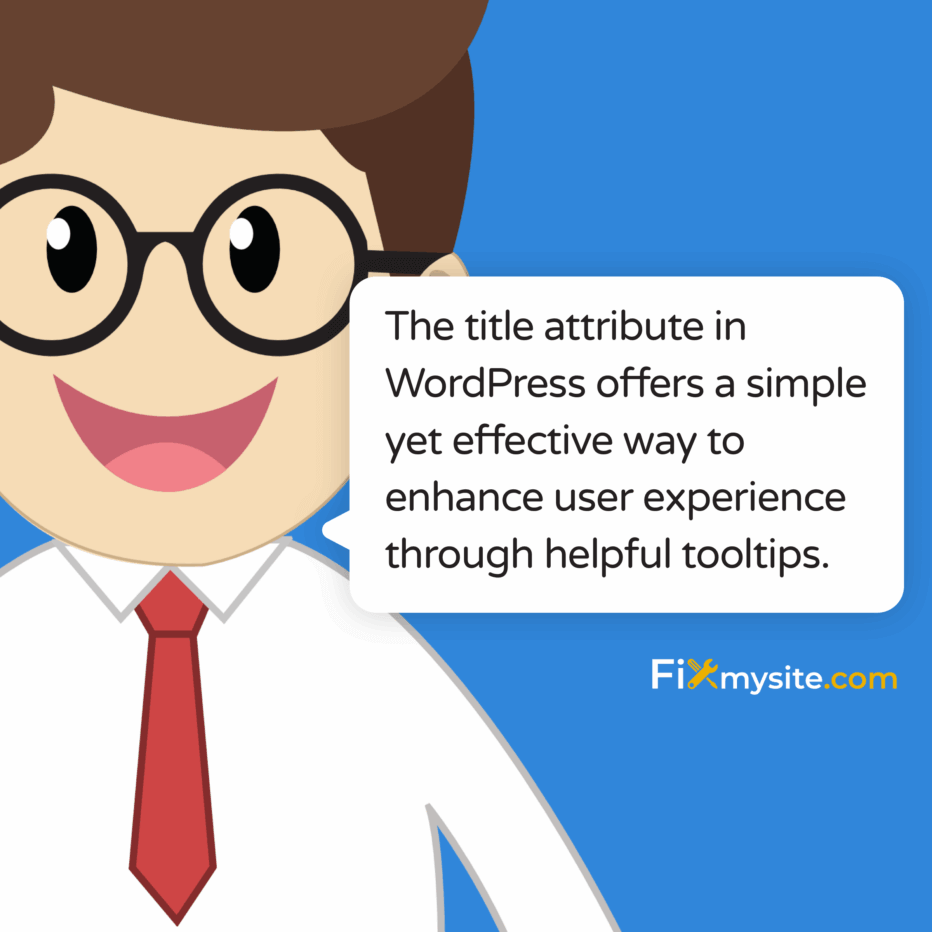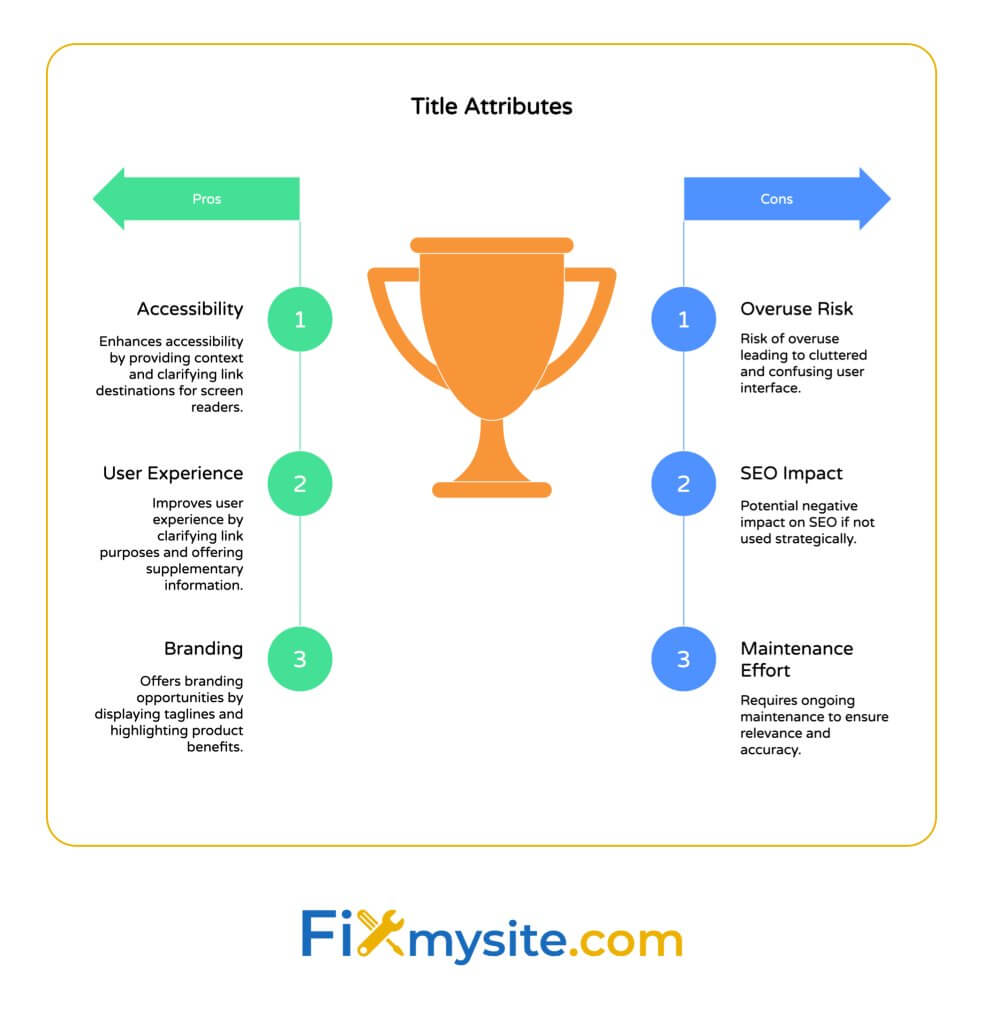
Have you noticed those helpful text tooltips that appear when you hover over links or images on certain websites? These informative pop-ups are created using the title attribute – a simple yet effective way to enhance your WordPress site’s user experience and accessibility.
The title attribute is often overlooked by many site owners. When properly implemented, it can improve how visitors interact with your site, provide additional context for screen reader users, and create a more intuitive browsing experience.
In this guide, we’ll explore what the title attribute is, how to implement it correctly in WordPress, and best practices to follow. You’ll learn practical ways to enhance your site’s usability without complex coding or expensive plugins.
Understanding the Title Attribute in WordPress
The title attribute in WordPress is an HTML element that provides supplementary information through tooltips, enhancing accessibility and user experience. When implemented correctly, it creates a small popup text box that appears when users hover their cursor over elements like links, images, or buttons. (Source: Liquid Web)
Think of the title attribute as a way to provide additional context without cluttering your page design. It works behind the scenes but becomes visible only when needed – creating a cleaner interface while still offering helpful information.
In WordPress specifically, you’ll find the title attribute integrated in several key areas:
| WordPress Element | Where to Find Title Attribute | Typical Use Case |
|---|---|---|
| Menu Items | Appearance → Menus → Title Attribute field | Explaining section contents |
| Images | Media Library → Attachment Details | Additional image context |
| Links | Link editor → Advanced options | Describing destination |
| Custom HTML | Custom HTML blocks or code | Technical explanations |
When a visitor hovers over an element with a title attribute, their browser displays the attribute’s text content as a tooltip. This behavior is consistent across most desktop browsers, creating a standardized user experience.
How to Add Title Attributes in WordPress

Adding title attributes to your WordPress site is straightforward. Let’s explore how to implement them for different elements.
Adding Title Attributes to Menu Items
WordPress makes it easy to add title attributes to your navigation menus through a built-in field. These tooltips can help visitors understand what they’ll find in each section before clicking. (Source: Hostinger)
Here’s how to add title attributes to your menu items:
- Log in to your WordPress dashboard
- Navigate to Appearance → Menus
- Select the menu you want to modify
- Click on the menu item to expand its options
- Look for the Title Attribute field
- Enter your tooltip text
- Click Save Menu to apply changes
The tooltip will now appear whenever visitors hover over that specific menu item. This additional information can help users better understand the content they’ll access by clicking that link.
Pro Tip
When visitors encounter WordPress-related issues like WordPress critical errors, well-implemented title attributes on navigation can help them quickly find help resources.
Adding Title Attributes to Images
Images are another important area where title attributes can provide context. Unlike alt text (which is essential for accessibility and SEO), the title attribute for images offers supplementary information that appears on hover.
To add title attributes to images:
| Method | Steps | Best For |
|---|---|---|
| Media Library | 1. Go to Media Library 2. Click on an image 3. Find “Title” field in attachment details 4. Enter your tooltip text 5. Save changes | Existing images |
| Block Editor | 1. Select an image block 2. Click on “Advanced” in the block settings 3. Add title attribute text 4. Update the page | New content creation |
| Classic Editor | 1. Click on an image 2. Click the edit icon 3. Go to Advanced tab 4. Enter title attribute 5. Update image | Sites using Classic Editor |
| HTML | Add title=”Your tooltip text” to img tags | Custom coding |
When implemented correctly, the title attribute can help provide additional context for your images. However, remember that the title attribute should complement, not replace, proper alt text for images.
Adding Title Attributes to Links and Custom HTML
For links and custom HTML elements, you’ll need to add the title attribute manually through HTML editing:
1. Switch to the HTML or Text editor view in WordPress
2. Locate the HTML element you want to modify
3. Add the title attribute within the tag: <a href=”page.html” title=”Your tooltip text here”>Link text</a>
4. Save your changes
This method gives you precise control over where and how title attributes appear on your site. It’s particularly useful when you need to add tooltips to custom elements beyond the standard WordPress options.
Benefits of Using Title Attributes
When implemented thoughtfully, title attributes can significantly enhance your WordPress site’s usability and accessibility.

Let’s explore the key benefits:
Accessibility Enhancements
The title attribute can serve as an accessibility aid by offering screen readers additional context, though support varies across different assistive technologies. While not all screen readers consistently announce title attributes, they can still provide valuable supplementary information for users with certain disabilities. (Source: TPGi)
For instance, when a link destination might not be obvious from the link text alone, a title attribute can clarify where the link leads, helping users make informed decisions before clicking.
Important Note
While title attributes can help with accessibility, they shouldn’t be your only accessibility measure. Comprehensive WordPress site security and accessibility requires multiple approaches working together.
User Experience Improvements
Beyond accessibility, title attributes directly enhance general user experience in several ways:
| UX Benefit | Description | Example Use |
|---|---|---|
| Clarified Link Purposes | Explains where links will take users | Title=”Download our pricing PDF (2MB)” |
| Preview Content | Offers a glimpse of what’s behind a link | Title=”View our 2025 project portfolio” |
| Additional Context | Provides supplementary information | Title=”Updated May 2025 with latest features” |
| Action Explanations | Clarifies what happens on interaction | Title=”Click to expand full specifications” |
These tooltips help users navigate your site more confidently by providing contextual information exactly when needed. This can be especially valuable for complex websites with many navigation options or for elements that might not be self-explanatory.
Branding Opportunities
Title attributes can also serve as subtle branding opportunities. For example, you can use title attributes on your homepage links to display company taglines or brief value propositions. This adds a layer of brand messaging without cluttering your visual design. (Source: WordPress.org Support)
This technique works particularly well for:
- Logo links (showing company mottos)
- Product links (highlighting key benefits)
- Service pages (offering brief descriptions)
- Team member links (showing roles or specialties)

Limitations and Considerations
While title attributes offer several benefits, they come with important limitations that should inform how and when you use them.
Mobile Experience Limitations
One significant limitation is that title attribute tooltips don’t appear on mobile devices. Since mobile users can’t “hover” in the same way desktop users can, they simply never see these tooltips. With mobile traffic making up a substantial portion of most websites’ visitors, this means many users won’t benefit from title attributes at all.
Screen Reader Compatibility
While title attributes can theoretically help with accessibility, their implementation across screen readers is inconsistent. Some screen readers ignore title attributes entirely, while others only read them under specific circumstances. This inconsistency means you should never rely on title attributes alone for critical accessibility information.
| Limitation | Impact | Alternative Approach |
|---|---|---|
| No mobile support | Mobile users miss tooltip information | Include essential info in visible text |
| Inconsistent screen reader support | Some users with disabilities miss information | Use proper ARIA labels and alt text |
| Limited SEO value | Minimal impact on search rankings | Focus on content, meta descriptions, and headings |
| Disappears quickly | Users may miss information if reading slowly | Keep tooltips concise and simple |
Given these limitations, it’s essential to use title attributes as a supplementary enhancement rather than a primary method of conveying important information.
SEO Considerations
From an SEO perspective, title attributes have minimal direct impact on search rankings. While they may marginally improve user engagement (which indirectly benefits SEO), they don’t carry significant weight as ranking factors. (Source: Yoast)
If your primary goal is improving SEO, you’re better off focusing on:
- Creating quality content
- Optimizing meta titles and descriptions
- Using proper heading structure
- Improving site speed
- Building quality backlinks
That said, anything that improves user experience can indirectly benefit SEO by increasing engagement metrics like time on page and reducing bounce rates.
Need Help With WordPress SEO?
If you’re looking to improve your WordPress site’s search performance, explore our guide on WordPress SEO plugins that actually work for practical solutions.
Best Practices for WordPress Title Attributes
To make the most of title attributes while working around their limitations, follow these best practices:
Creating Effective Title Attribute Content
When crafting the text for your title attributes, keep these guidelines in mind:
| Best Practice | Correct Example | Poor Example |
|---|---|---|
| Keep tooltips concise (4-10 words) | “Download our 2025 price guide” | “Click here to download our comprehensive 2025 pricing guide with all package options and detailed service descriptions” |
| Avoid redundancy with visible text | Link: “Products”Title: “Browse our eco-friendly product range” | Link: “Products”Title: “Products” |
| Use plain language | “Learn how to set up WordPress” | “Acquire knowledge regarding WordPress CMS implementation procedures” |
| Provide supplementary information | “Updated June 2025” | Repeating information already visible on the page |
The goal is to create tooltips that add value without overwhelming users. Keep them brief, informative, and complementary to the visible content.
When to Use (and Not Use) Title Attributes
Title attributes are most effective when:
- Providing additional context for ambiguous links
- Explaining non-standard functionality
- Offering supplementary information for images
- Describing where a link will take users
- Adding subtle branding elements
However, avoid using title attributes for:
- Critical information that all users need to see
- Primary content that should be visible without interaction
- Essential instructions or warnings
- Key navigation elements that might be unclear without the tooltip
- Lengthy explanations that would be better as visible text
Remember that title attributes should enhance the user experience, not serve as a crutch for poor design or unclear content.
Element-Specific Recommendations
Different WordPress elements benefit from different approaches to title attributes:
| Element Type | Recommended Title Attribute Use | Example |
|---|---|---|
| Navigation Menus | Brief descriptions of section contents | Title=”Latest articles on WordPress development” |
| Images | Supplementary details beyond alt text | Title=”Photo taken at our 2025 conference in Seattle” |
| Call-to-Action Buttons | What happens after clicking | Title=”You’ll be taken to our secure payment processor” |
| Form Elements | Additional guidance on completion | Title=”Enter your full legal name as it appears on your ID” |
| Icons | Explaining icon meaning | Title=”Save your changes” |
By tailoring your approach to each element type, you can create a more intuitive and helpful user experience throughout your WordPress site.
WordPress Optimization Tip
While implementing title attributes, consider also reviewing your site’s overall performance. Our guide on fixing slow WordPress sites can help you identify and resolve speed issues that might be affecting user experience.

Conclusion
The title attribute in WordPress offers a simple yet effective way to enhance user experience through helpful tooltips. When implemented thoughtfully, these tooltips can provide supplementary information, improve navigation clarity, and add subtle context throughout your site.
However, it’s important to remember the limitations of title attributes – particularly their lack of visibility on mobile devices and inconsistent screen reader support. Use title attributes as one component of a broader user experience and accessibility strategy, not as your primary method for conveying critical information.
By following the best practices outlined in this guide, you can implement title attributes in ways that genuinely benefit your visitors without relying on them for essential content. Focus on creating concise, helpful tooltips that complement your visible content and enhance the overall usability of your WordPress site.
Remember that small touches like well-implemented title attributes can contribute to a more polished, user-friendly website experience. While they may seem like minor details, these enhancements demonstrate attention to user needs and can help differentiate your site from competitors.
Need help optimizing your WordPress site for better user experience and performance? Contact our WordPress support team for assistance with site improvements, troubleshooting, and maintenance.



